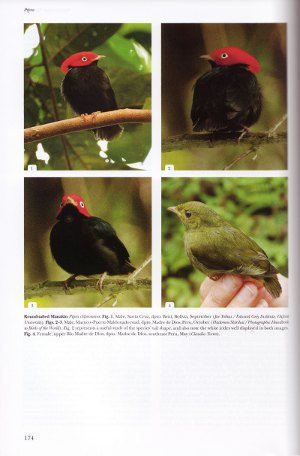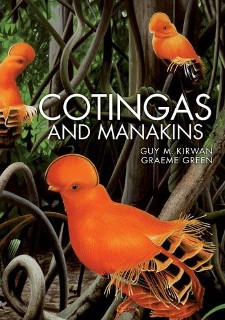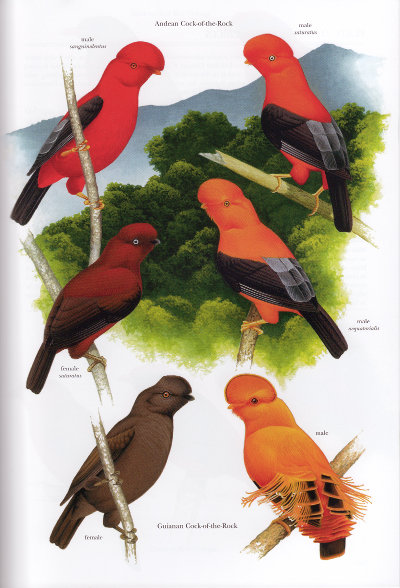Reviewed by Frank Lambert on February 13th, 2012.
The Neotropical region has the richest bird fauna on Earth, and two groups found exclusively in this region are the Cotingas and the Manakins. The two groups include not only some of the rarest and most enigmatic of birds but also some of the best-understood of all tropical bird species. Many are breathtakingly colourful, including such bizarre species as the Cock-of-the-Rocks, Bellbirds, Fruitcrows and Umbrellabirds, while others are most elusive, such as the Fruiteaters and Purpletufts, not to mention Kinglet Calyptura Calyptura cristata – a species only seen once in more than a century. As such, they have enormous appeal to birders, me included.
I first became fascinated by these wonderful birds when I read David Snow’s outstanding book The Web of Adaptation – now long out of print. Since that time – some 30 years ago – I have managed to see many of the species that he wrote about, and they are always a marvel to watch, and it is very satisfying to now have such a comprehensive book about them. But it is not only birders who will appreciate this book, because research on the natural history and behaviour of both Cotingas and Manakins has generated many important insights into evolutionary biology – the main subject of that book by David Snow that I read so long ago. Cotingas and Manakins provides a comprehensive summary of all that is known about these fascinating birds and should therefore have much appeal to scientists as well as birders.
Cotingas and Manakins follows in the style of several other recent hefty Helm Identification Guides such as Reed and Bush Warblers and Pipits and Wagtails
. It covers 130 species which are nicely illustrated on 34 colour plates by Eustace Barnes – though note that only adult birds are illustrated. There are also about 400 colour photos of exceptional quality, many taken by Hadoram Shirihai from the collection of the Photographic Handbook to Birds of the World (Jornvall and Shirihai – in preparation), and with the exception of the critically endangered Kinglet Calyptura (shown as a specimen) all photos are of wild birds.
 The book has taken many years to complete and is well researched, with over 1700 papers and publications listed as references. The authors also include many personal field observations and unpublished museum studies. Each species account has in-depth coverage of identification, distribution, habitat and movements, a detailed plumage description with comprehensive measurements for different subspecies, a section on geographic variation, another on threat status, and notes on voice. In many cases, several pages are devoted to aspects of natural history of the species, such as display, food and feeding, and breeding. All species accounts have detailed colour range maps, though ranges of individual subspecies are generally not shown. Short introductory chapters include a substantial summary of the systematics of the birds included in this book – something very necessary in view of our rapidly changing understanding of the relationships within these groups.
The book has taken many years to complete and is well researched, with over 1700 papers and publications listed as references. The authors also include many personal field observations and unpublished museum studies. Each species account has in-depth coverage of identification, distribution, habitat and movements, a detailed plumage description with comprehensive measurements for different subspecies, a section on geographic variation, another on threat status, and notes on voice. In many cases, several pages are devoted to aspects of natural history of the species, such as display, food and feeding, and breeding. All species accounts have detailed colour range maps, though ranges of individual subspecies are generally not shown. Short introductory chapters include a substantial summary of the systematics of the birds included in this book – something very necessary in view of our rapidly changing understanding of the relationships within these groups.
Some 20 years ago, when work on this book started, the species covered were generally considered to fall into only two families, but recent molecular studies have demonstrated that this diverse assemblage of species belong to at least five families. Many of the changes that have occurred are acknowledged in this book, and they were clearly changing as the book proceeded so that some species that are included are no longer considered to belong within the Cotingas or Manakins. Many birders are now using the world bird list of the IOC since this reflects the results of recent molecular and other studies and is regularly updated. Hence, comparing IOC’s list with those in Cotingas and Manakins reveals a few significant differences. For example, IOC splits Elegant Mourner Laniisoma elegans into Brazilian Laniisoma L. elegans (Southeast Brazil) and Andean Laniisoma L. buckleyi; and more interestingly, removes the genus Piprites as well as Swallow-tailed Cotinga Phibalura flavirostirs and Kinglet Calyptura from the Cotingidae to Incertae Sedis due to lack of data on their relationships. Furthermore, studies have shown that Sapayoa is more closely related to Old World Suboscines than to any New World Suboscines and it has also been removed from the Cotingidae and is now included within the Eurylaimidae (Broadbills and relatives). Nevertheless, the birds included in this fantastic tome fall more or less into a coherent group for the purpose of the book, and taking out these species would have been a pity – so I for one am glad to find such species as Swallow-tailed Cotinga included in the book.
Overall, Cotingas and Manakins is a brilliant piece of work and well worth having in your library. I have regularly dipped into the various species accounts and reminded myself of just how much I have enjoyed seeing these birds on my various trips to the Neotropics. And, of course, I am reminded of how much I want to go and see some more!
– Reviewed by Frank Lambert
This book has been co-published by Princeton University Press in the U.S. and Christopher Helm in the UK.
Disclosure: I get a small commission for purchases made through links in this post.






Comment